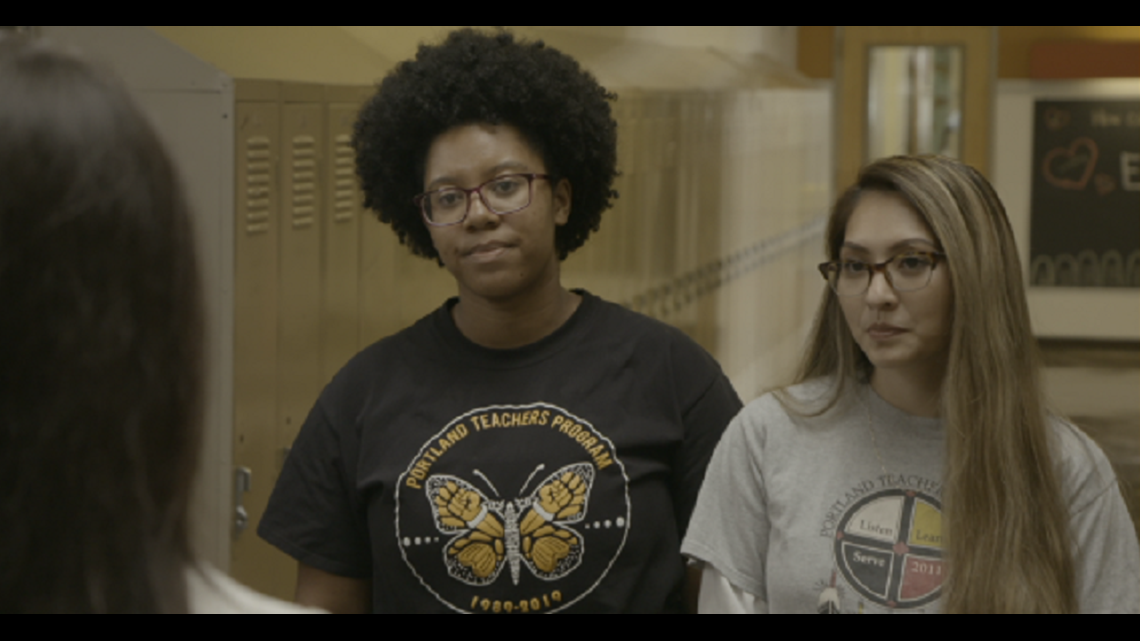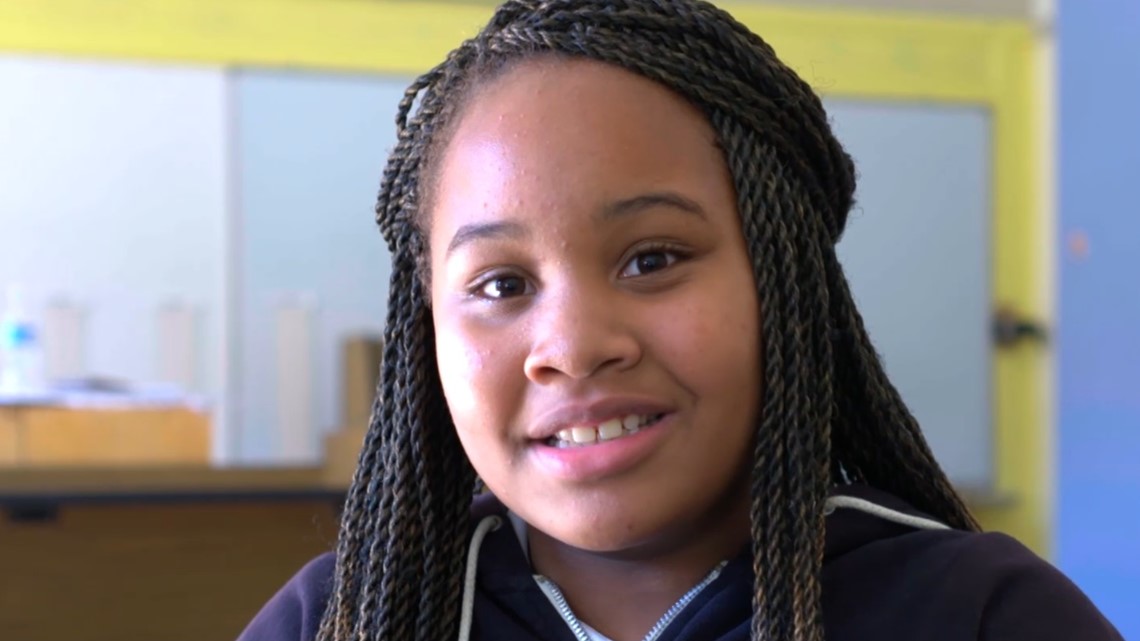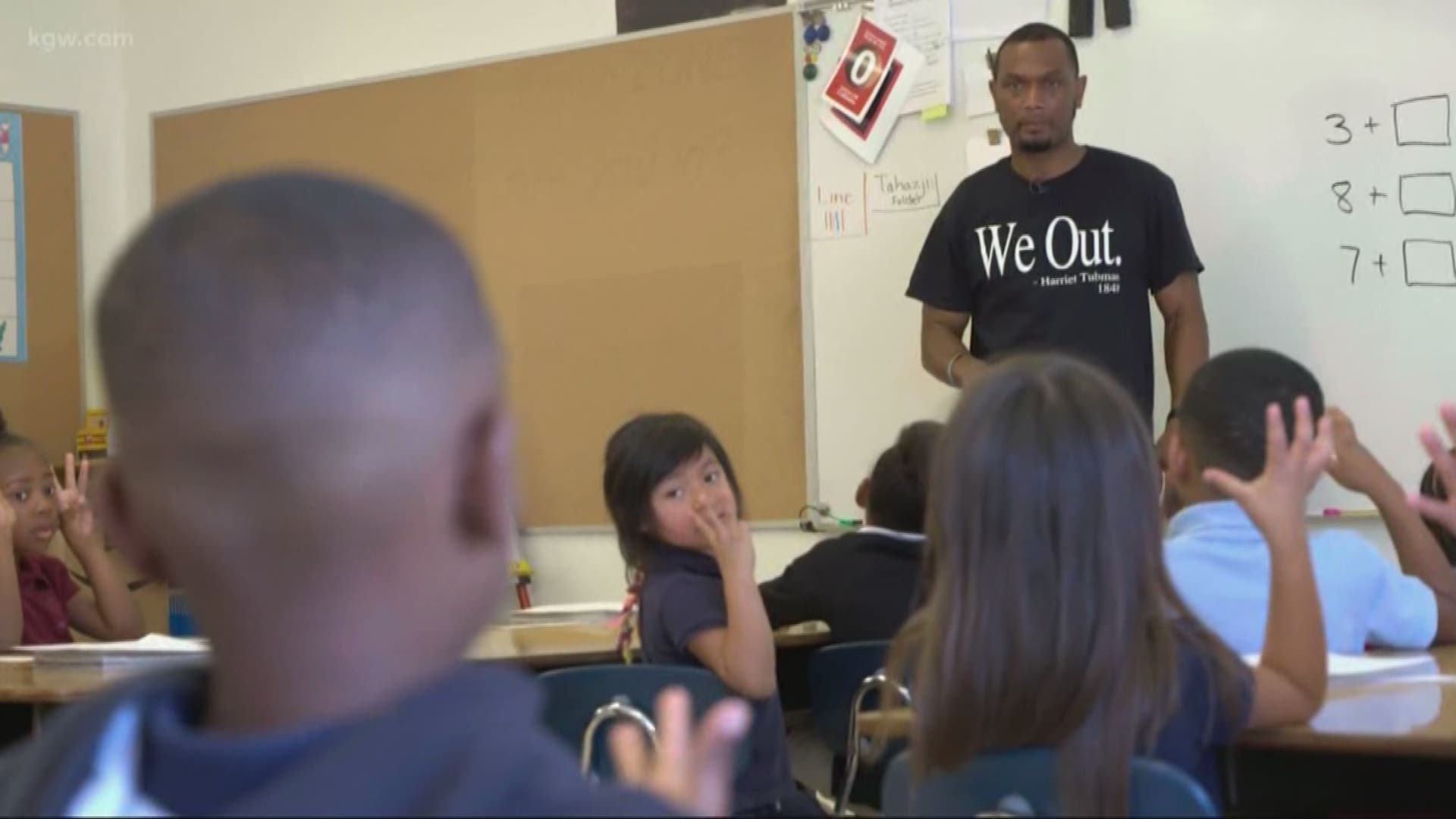Inside Woodlawn: Program that recruits teachers of color in danger of ending
“I don't think you'll ever find two black teachers in first grade in the state of Oregon. I think that's like a unicorn,” Woodlawn teacher Anthony Lowery said.

Talk with teachers at Woodlawn Elementary School and it quickly becomes clear there is one educator who many admire and respect.
Lionel Clegg is something of an institution at Woodlawn. He grew up in the Northeast Portland neighborhood and attended the school as a child. He returned to the school as an adult and has now taught there for 21 years.
As an African-American man, he’s also a role model to both students of color and his fellow teachers of color.
“Woodlawn helped me learn to be who I was growing up,” Clegg said. “There was a fourth-grade teacher that I had, her name was Rolia Manyongai, and she was actually the first teacher of color that I ever had. She gave me a great sense of pride about being who I was.”
Clegg is a rarity in Oregon, which doesn’t have large numbers of black, male teachers. In fact, the state doesn’t have many teachers of color.
According to a 2018 study, 10% of teachers in Oregon are ethnically diverse compared to nearly 40% of students.
While the state of Oregon has had difficulty hiring and retaining teachers of color, it is a different story at Woodlawn Elementary School.
The diverse student body has teachers who look like them which is a point of pride at the school.
Anthony Lowery, who is also black, teaches first grade alongside Clegg.
“I don't think you'll ever find two black teachers in first grade in the state of Oregon. I think that's like a unicorn,” Lowery said.


Portland Teachers Program was key Hundreds of teachers have benefited
The pair met when Lowery was Clegg’s student teacher at Woodlawn. Both men participated in a program through Portland Community College and Portland State University called the Portland Teachers Program. The program recruits and places teachers of color in both Portland and Beaverton schools.
Clegg credits the program, known as PTP, for his success as an educator.
“As far as being the well-rounded teacher than I am and having that understanding of how to work with all children and also the respect to learn from them as well has been very vital,” Clegg said. “It's really because of PTP that I am the way that I am now.”
Lowery found PTP at a crossroads in his life. He was laid off after 12 years at Nike and was coaching basketball when another teacher told him to check out the program.
“They really gave my life purpose,” Lowery said. “It gave my life meaning. I never really knew what my life was meant to be, but now that I'm here as a teacher, it’s like, man, I don't see myself doing anything else.”
The Portland Teachers Program is now at a crossroads of its own. After graduating 230 teachers in the past three decades, the program now is in danger of ending.
While PSU recently put $500,000 toward the program, that will only pay for the current PTP students, including Woodlawn student teachers Unique Robinson and Emily Nguyen, to finish school.
The director of the program confirmed the program is no longer accepting new students while officials discuss how to move forward.
“I'm constantly just thinking about what the future can hold, whether that's new partnerships with other universities or whether that's funding from the state, whatever that is. But there's something needs to happen for us to continue to do the work that we are doing,” said Robinson.
“Knowing that a program like this might not continue, it worries me for the future of education. And not just in Portland, but I feel like this is something that needs to be modeled, like this program is something that needs to be replicated all over,” said Nguyen.


PCC supportive of program Current class can continue
Kate Chester at Portland Community College said the school's commitment to PTP hasn’t changed even though PSU is not able to provide the full tuition waivers for future students as has been the practice.
“PCC is using this period to assess how the reduction of tuition support will impact the program in terms of size and scope. Simultaneously, we’re in conversation with other local 4-year institutions to explore their interest in partnering with us on the program. And we intend to recruit students for the spring term,” said Chester in an email.
“PCC has no plans to close the Portland Teachers Program in spite of the latest developments, and we remain fully committed to sustaining our part of the pipeline,” she continued. “Our other partners – Beaverton School District and Portland Public School District – also remain committed to the purpose of the program and its continuation. The Portland Teachers Program, as we know it, may change; however, our work and commitment to preparing teachers of color remains.”
Fourth grade teacher Jai Blair said teachers of color are sometimes able to broach sensitive topics with students.
“I'm able to talk about things in a more comfortable manner, whether it's between race. If we're talking about like historical things, I'm not afraid to talk about it with the students. I don't shy away from it. I don't try to sugar coat it,” said Blair.
Olivia Livingstone, a fifth-grader at Woodlawn, said she has noticed the benefit of having black teachers.


“When I was little, I didn’t understand what racism was or anything like that. But now that I’ve had teachers that look like me, explain it to me, it’s part of my history so it makes me feel happy that they’re talking about it and being in their classes just makes me happy,” Olivia said.
Cathy Parker, a reading specialist at Woodlawn, said she became a teacher so that children in Oregon could see people of color in schools.
“When I came to Oregon, I came as a high school student and we lived out in Newburg and they had assembly to announce we were the first black family to ever integrate the high school. They had the assembly before we even got there to let the teachers and the students know how to treat us and I thought that was the weirdest thing ever,” Parker said.
The local newspaper wrote articles years later about the town’s first African American family and how they were mistreated at the school.
“When I came back [to Oregon] 20 years later and I brought my kids back to stay with my mom because she lives in Sherwood, the exact same thing happened. I'm like, 20 years later? So [I told myself], you know what? I need to get into school. I need to be that teacher because they didn't know how to treat us,” said Parker.
Benefit for students Seeing teachers as role models
The teachers agree having educators of color not only aids students of color, but all races, at the school.
“I mean it's also great for kids of all colors because they get different perspective and teachers. I've had great success with my Caucasian students because I give them my perspective. And a lot of times the kids don't get more than one perspective all the way through school,” said Lowery.
These are the reasons why the graduates of Portland Teachers Program say it’s so critical; it helps bring teachers with an important perspective into Portland and Beaverton schools.
And Margarita Portillo, a substitute teacher and PTP graduate, points out that it is far from a free ride.
“You pay for your books, you pay for anything else extra, like your living expenses, but you needed to come to meetings every month. You write papers, you needed to research, you needed to do all these extra things and carry a B-average,” said Portillo.
Lowery said the if the program ends, it’s just another indicator of gentrification in an already-changed Woodlawn neighborhood.
“I think that just Portland State not really wanting to support us as kind of like, I figured it's just another part of gentrification ... this is another nail in the coffin to really get into, you know, eliminating the black community in Northeast,” said Lowery.
About Inside Woodlawn:
KGW is spending the 2019-2020 school year at Woodlawn Elementary School, telling stories of the staff, students and community through the series “Inside Woodlawn.”
KGW investigative reporter Cristin Severance and photojournalist Gene Cotton will be reporting periodically throughout the school year, with vignettes and full-length episodes.
Please follow ‘Inside Woodlawn’ on YouTube, Facebook and by using #insidewoodlawn on Twitter and Instagram.


